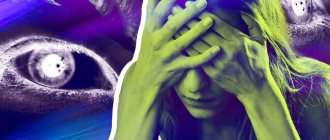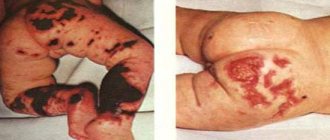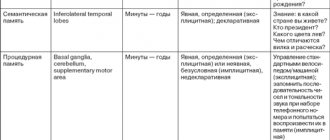Schizophrenia in children is an extremely rare phenomenon.
It usually “blooms” during adolescence. In psychiatry, childhood schizophrenia is a disease that manifests itself before the age of 12. The disorder in children is characterized by some specificity of symptoms and difficulty in diagnosis. The vigilance of parents and a qualified specialist will help to recognize the disease in time and begin timely therapy.
What causes the disorder
It is immediately worth noting that the exact, final cause of childhood schizophrenia has not yet been clarified, and the probable ones can be defined as combined. Both biological and social factors play a role here.
Among the biological predisposing factors, primarily genetics and heredity are distinguished. It has been established that the majority of children suffering from the disorder have sick relatives, either immediate or even secondary.
Biological causes also include damage to the central nervous system. Damage to brain structure plays an important role in the manifestation of the disorder. They are divided into perinatal and postnatal.
Perinatal risk factors are defects acquired in the womb. They can develop due to:
- intrauterine fetal hypoxia;
- intrauterine infections;
- placental abruption;
- lack of nutrition;
- toxic effects on the fetus - maternal abuse of alcohol and drugs during pregnancy; taking medications prohibited for pregnant women; if the pregnant woman has been exposed to toxic substances.
Postnatal risk factors include those that affect the child after birth. Traumatic brain injuries play a special role here. This group also includes neuroinfections, that is, infections that destroy brain tissue: encephalitis, meningitis, neurosyphilis. Conditions that cause brain hypoxia predispose to the development of the disease.
But all these reasons may be powerless if the child is surrounded by a prosperous social environment.
The risk appears if a child grows up and is brought up in an unfriendly, oppressive atmosphere. This concerns the violence to which the child is subjected: beatings, aggression from parents, systematic accusations, inadequate assessment of actions. Child abuse often occurs in families where parents are drug addicts or alcohol abusers.
Another model of behavior is when parents raise their child with excessive severity, make excessive demands on him, dictate their preferences, and establish increased control. That is, education from the cycle: “a step to the left, a step to the right - execution.”
In another family, the child seems to live and be raised according to the rules, but the relationship between the parents does not work out. Constant quarrels, scandals, misunderstandings between spouses leave a negative imprint on the child’s psyche, especially if he witnesses violence.
But it also happens that the family is quite prosperous, the relationships between its members are positive and friendly, but the baby was exposed to a severe stress factor. This could be the death of a loved one, violence, or a child witnessing a terrible event. In this case, there is also a risk of manifestation of the disorder.
Symptoms
The signs of schizophrenia in adolescents are not very different from its manifestations in adults. Most often this is the same delusion, hallucinations, personality disorder.
One can observe rudimentary delusional distortions of thinking in the form of various fears and phobias. They are intrusive and literally pursue the patient. Among them are:
- Fear of other people's parents. The child begins to suspect his own parents that they are not his own. He is afraid of them, does not make contact, and refuses to eat.
- Fear of contamination, which is often accompanied by compulsive hand washing. The teenager does this at every opportunity, regardless of his location.
- Fear of open space – agoraphobia. The patient wants to hide somewhere, to become invisible.
Attention should be paid to the adequacy of the child’s reaction. It happens that to a situation that should make a person sad or upset, he reacts with a fit of laughter and feigned fun. The most common emotional disorders are:
- fenced off;
- isolation;
- absence of any manifestations of emotions, monotonous reaction to events happening around;
- loss of interest in previously favorite activities.
On the part of motor disorders, there may be repeated stereotypical movements, freezing in some unnatural positions, poor posture, strange gait, etc. Sometimes the angularity and awkwardness of movements can be attributed to adolescence or the accelerated growth of a teenager. But this pattern only works if the child has only these manifestations and they do not get worse over time.
Early childhood schizophrenia
Symptoms and signs of childhood schizophrenia have many similarities with its course in adults. But, nevertheless, they are not without specific manifestations, which, it must be said, complicate its diagnosis.
The disease is divided into three types, covering different age periods:
- schizophrenia of early age – from 0 to 3 years;
- preschool age - from 3 to 5–7 years;
- school age - after 7 years;
Surprisingly, the first signs of schizophrenia in children can be noticed already in infancy, in the first year of life, although during this period they appear quite rarely. The difficulty is this: they are so vague and atypical that not every mother can suspect the onset of a mental disorder in them:
- the child is lethargic and inactive. Doesn't respond to toys. Doesn't wake up for feeding, doesn't cry before feeding. It seems that he does not feel hungry. Shows emotional coldness towards the mother: does not smile at her, does not reach out to her. Indifferent to uncomfortable conditions;
- motor excitation. Occurs during the daytime. The child lies in the crib and jerks his arms and legs. But these movements are not similar to normal age-related motor activity. They are monotonous, reminiscent of automatisms. They occur against a reduced emotional background, that is, the baby does not show any emotions. Motor skills do not become more difficult with age. Moreover, those already acquired are lost;
- affective disorders. Excessive tearfulness appears. The baby cries both day and night. Anxiety and crying occur in periods, alternating with phases of relative calm. For example, anxiety attacks can be repeated 2-3 times during the night.
Symptoms of schizophrenia in children of the second or third year of life are accompanied, first of all, by the extinction of emotions. Children become inactive, unsmiling, and unemotional. In some cases, children who have already begun to walk lose this ability. They begin to crawl, their movements acquire a chaotic direction, developmentally corresponding to one month of age.
On the other hand, such kids become excited. They are often in a state of constant, aimless walking, in a circle or in the form of a pendulum, swaying from side to side. At the same time, the face becomes detached or the children begin to make different grimaces. Despite walking for a long time (1 hour or more), they do not get tired. It becomes very difficult to stop them from aimless desires. They break free and continue the process.
Disorder at this age can also be expressed in unreasonable laughter or crying, in disorganized running and jumping.
Sharp excitement gives way to lethargy. Children tend to lie down in a quiet, distant place: under the bed, in the corner. They take an unnatural pose. It is very difficult to take them out for a walk; you have to do it by force. Sleep is also disturbed. Kids wake up in the middle of the night and spend a long time without sleep.
In general, the picture of the disease in children under 3 years of age comes down to aimless movements and automatisms, and regression in development. Against the background of a pathological condition, fears arise that have no basis. This could be a fear of any object: cars, trees, etc. When a frightening object comes into view, the child becomes anxious and excited. But once you remove it from sight, the baby’s condition returns to normal.
KANNER'S SYNDROME
Leo Kanner made a major contribution to the study of the symptoms of early childhood schizophrenia. The psychiatrist identified such indicative signs in children of this group as:
- impersonal relationships with parents;
- monotonous games with stereotypical movements;
- ignoring personal pronouns.
The doctor combined these signs with the term early childhood autism. Subsequently, it turned out that the autism he identified is an integral sign of schizophrenic disorder. Autism within schizophrenia is often represented by the concept of “Kanner syndrome”.
As infants, such children had sleep disturbances, its depth and quality changed. It became superficial, and patients had difficulty falling asleep.
Children tend to become restless and tearful for no apparent reason. Although some children have a stable emotional background. There may be a decrease in sensitivity to sound stimuli. Sometimes it seems that the child is deaf.
With age, young patients show signs of the disorder more clearly. It is difficult for them to master basic self-care skills: brushing teeth, getting dressed, folding things. Although speech is formed in a timely manner, it subsequently loses its emotional coloring. Children stop asking and answering questions. Many words fall out of use. Phrases are shortened, sometimes not completed, pronounced in a chanted, fragmentary, cliched manner. The usual intonation is lost, acquiring an elaborate character: the emphasis and manner of pronunciation change. Children's speech is characterized by slurredness, incomprehensibility, monotony, and automaticity, and therefore is not suitable for communication.
The behavior of a baby suffering from Kanner syndrome can be characterized as satisfactory, even with a hint of fun. Some cases are reinforced by indifference to the environment. However, such a mood background persists when the situation around the child is stable. It is necessary to make changes and adjustments to the child’s usual way of life - change the route of walks, change the interior of the room, diversify the food, the behavior of the little patient changes. He becomes aggressive, restless, anxious.
Children's play activities seem normal in appearance, but are characterized by a rapid change of actions or getting stuck on one particular one, and the absence of a game plot. It is difficult to interest children in familiar toys. They show interest in other things: numbers, household items, electrical engineering. The activity is accompanied by stereotyping and monotony, for example, aimless counting of any objects that come across.
Motor activity changes. Increasingly complex motor forms are combined with preserved primitive movements: flapping of the hands, fingering of the fingers, their flexion, extension. Such stereotypies are typical for the early age period. The gait becomes uncoordinated, abrupt, jerky. There is no smooth movement. One is struck by the gracefulness of some motor acts and the absurdity and awkwardness of others.
Andryusha, 4 years old. Infancy was accompanied by normal development: he began to sit and walk on time, speech development - from 1 year. The mother noted the child’s excessive calmness, passivity and drowsiness, and a weak reaction to toys. He did not distinguish between strangers and relatives, showing the same reaction.
The boy was afraid of other children, ran away from them, and did not want to play with them. An attempt to involve a child in a game ended in aggression, irritation, anxiety, and screaming. He loved to walk on tiptoes or with his feet wide apart, jump, and perform various manipulations with his hands. The game was accompanied by moving toys from place to place. There was no play activity outside. When he met a dog, he screamed: “Don’t be afraid,” hitting himself in the face.
Having developed speech and a good vocabulary, he does not use speech. Ignores questions and requests. Expresses individual short phrases when he feels the need for something, and gestures more often. Loves to listen to poetry, remembers what he reads and the page where the poem is printed. He talks about himself in the third person: the boy goes for a walk, the boy wants to eat.
Suspecting oligophrenia, he was sent to see a doctor. He wandered or ran around in the office and ignored requests to sit on a chair. Didn't answer questions. He threw the offered toys onto the floor. He screamed, shouting out incomprehensible words. Broke a photo frame by hitting it on the table.
Schizophrenia in preschool children
In children aged 3 to 7 years, the disease begins with emotional coldness. Children become indifferent to what is happening, limit communication with peers, and do not show warm feelings towards their parents. Previously acquired knowledge and skills are lost, interest in favorite activities and toys disappears.
Little patients become capricious, and their mood undergoes sudden changes and fluctuates over a wide range.
Children do not show interest in their appearance and refuse to perform daily hygiene procedures. They become sloppy, may wear dirty clothes, and go to sleep on the floor.
Behavior also changes. In their actions they can display the manners of younger children. For example, a child who was already quite fluent in using a spoon and fork, suddenly begins to eat with his hands, scatters food, and crumbles it.
He spends almost all his time alone, fencing himself off from people. It is difficult to tolerate innovations in his regime. His games become primitive, losing their plot. They come down to feeling objects and toys, sniffing them. The theme of the game does not matter - such children are attracted only to individual actions. In other words, games take on a stereotypical character: a preschool child opens and closes the closet door, arranges objects in a certain sequence. If his work is interrupted, he becomes very angry.
The disorder has a particular impact on speech. So, if the child has already expressed his thoughts well and competently, then at the beginning of the illness one can note a violation of the semantic arrangement of words in a sentence. Gradually, speech becomes incoherent, the child is unable to clearly express his thoughts. Echolalia appears - repetition of words spoken by someone. Little by little, a full-fledged, intelligible narrative becomes incoherent and incomprehensible. Sentences are shortened, words are replaced with syllables. Soon the speech turns into incoherent babble.
As the process progresses, children show signs of catatonia. They are inhibited, frozen in one position. For example, they sit bent over and throw their head back, or lie in a fetal position. At the same time, the look is absent, they do not make contact.
The other side of catatonia is elevated mood, agitated behavior. The child jumps, laughs, fools around for no reason.
SIGNS OF THE DISEASE
Regarding schizophrenia, a simple rule applies: the earlier the disorder is detected, the better the prognosis. Early childhood schizophrenia manifests itself in infancy. However, few parents think about the presence of the disease, rather justifying the symptoms of a mental disorder with crisis periods of development or shortcomings in upbringing.
Since children tend to fantasize and have unstable mental reactions, the disease is difficult to diagnose before the age of 7. Psychiatrists lack a clear picture to make a diagnosis. More often, an official conclusion is made at puberty, during the period of manifestation of the disorder caused by hormonal surges. But by this age, the disease has time to take root, forming stable pathological personality changes, which complicates the upcoming treatment. Adolescent schizophrenia is diagnosed in only 2% of patients.
Thus, the childhood form is a complex type of the disease. It is characterized by a severe course, a confused clinical picture, and persistent irreversible changes in the psyche.
Productive symptoms of childhood schizophrenia
Schizophrenia in preschool children manifests itself in the form of pathological fantasizing. What distinguishes it from typical children's fantasies is the unreality and persistence of the imaginary. Painful fantasies are pretentious in their themes, and are accompanied by changes in behavior.
The child is reincarnated into some object and is able to remain in his new role for several days. For example, a boy, seeing himself as a car, twisted his arms and moved his legs, imitating its driving. I stopped periodically to refuel as I was running out of gas. Everyday needs were carried out automatically, and then under the pressure of adults.
Fantasies in the form of fairy-tale creatures, monsters, and dragons are common.
Productive symptoms in preschoolers are also represented by delusions and hallucinations. But they are less pronounced than in school-age children and adults.
Hallucinations can be visual, auditory, or oral in nature. Visual hallucinations usually appear at the moment of falling asleep or waking up. The child develops a feeling of fear and anxiety. He peers into the room, directs his gaze to a certain part of the room. He says there is a blue wolf standing there, there are a lot of spiders on the ceiling, or a snake is crawling on the bed. He sees a glowing face and a black paw.
Auditory hallucinations in young children rarely involve voices in the head. More often they “come” in the form of a rooster’s crow, the striking of a clock, someone’s crying, the voice of evil forces: a witch, an evil sorcerer, villains from cartoons.
Oral quirks include sensations such as a burning sensation in the mouth, the presence of an object, hair, or crumbs.
Among delusional ideas, the delusion of persecution comes to the fore.
Stages of the disorder
Whatever the causes of schizophrenia in adolescents, it begins slowly and imperceptibly. One of the first manifestations is a feeling of internal discomfort. It has no reason, but keeps a person in constant stress and tension.
The following stages of development of the disorder and the measures taken should be highlighted:
- Prodromal. At this stage of the disease, adolescents are characterized by problems associated with concentration, sleep disturbances, and difficulties at school. Making a diagnosis of schizophrenia at this stage is impossible; the goal of the diagnostic process is to form specific risk groups and carry out specific prevention.
- Spicy. Productive symptoms predominate: hallucinations, delusions, disorders of formal thinking, strange psychotic behavior. The most specific are auditory hallucinations. They occur in 80% of patients aged 12 to 18 years.
- Response to treatment and reduction of symptoms of the disease. The goal of therapy at this stage is to monitor and correct side effects of therapy and achieve remission.
- Maturing remission. There are residual positive and negative symptoms of schizophrenia associated with side effects of therapy. At this stage, stable remission is achieved, factors that may cause a relapse are eliminated, a commitment to long-term maintenance therapy is formed, and social functioning is restored.
- Recovery. At this level, monitoring of compliance with the maintenance therapy regimen, social support, and relapse prevention are carried out.
- Chronic. The progression of this stage indicates the teenager’s resistance to the treatment methods used. Deactualization and partial reduction of positive symptoms occur, but social isolation, apathy and abulia persist. Negative symptoms cause a child's low level of social functioning.
Schizophrenia affects the most subtle layers of a teenager’s psyche and manifests itself in the sphere of self-awareness and perception of the surrounding reality.
School age schizophrenia
Starting from the age of 6–7 years, the child spends most of his time at school. Therefore, the onset of the disease can be determined by the nature of the educational activity. Such children are noticeably behind in mastering educational material compared to their peers. All their cognitive functions suffer, their voluntary attention is poorly developed, that is, it is very difficult to keep it focused on the material being taught. But involuntary attention in such children, on the contrary, is more pronounced.
The problem of perception lies in understanding the integrity of the picture. It is difficult for a child to grasp the general meaning. He breaks down what he says or sees into separate parts. Memory is selective. Only that which sincerely interests the sick child is remembered. It is almost impossible to force him to learn educational material if he does not want to.
Such children drop out of the life of the team. They remain aloof and withdraw into their own world. They develop strange passions and hobbies. They are characterized by fragmented thinking, reasoning, and separation from reality. Their thoughts take on a dark and frightening character. Children are suspicious, look for a trick in everything, and may assume that everyone is watching them. Gradually they become autistic, separate from the world around them, and withdraw into themselves.
Abulia develops - lack of will. It is difficult for a child to persuade himself to engage in activities, although he understands the need for this. He spends most of his time in bed, refuses to go to school, and does not communicate with friends.
As the disease progresses, delusions and hallucinations join the symptoms. The latter appear in the form of voices that frighten and incline to a certain action. Often children are silent about their appearance.
Gradually, the disease takes on one of its forms. Childhood schizophrenia manifests itself in the following forms:
- sluggish – the most common form of the disorder. Its early sign can be superpowers in any area - drawing, mathematics, music. But over time they are lost. Children suffering from this form of the disease are characterized by pathological fantasies, obsessive fears, and fanciful hobbies;
- paroxysmal - progressive - the symptoms of the disease are not clearly expressed. And it manifests itself in periods. But it leads to irreversible consequences like schizophrenia;
- paranoid – occurs less frequently than other forms. Among its symptoms are delusions of persecution, poisoning, malignant fantasies and fears. Expressed emotional coldness;
- hebephrenic – excited, aggressive behavior. Characteristic are antics, grimacing, pretentiousness;
- catatonic - taking pretentious poses and freezing in them or increased impulsiveness and excitability in actions. Meaningless speech, imitating movements, words of other people.
First manifestations
The initial signs of schizophrenia in a teenager can be noticed in childhood. But they are irregular and expressed sporadically, so parents attribute them to some individual character traits, fatigue or moodiness. Besides, it’s hardly anyone’s pleasure to suspect their own child has a mental disorder.
It will not be difficult to see changes in a child’s behavior if he led an energetic lifestyle: he studied well, actively communicated with friends, was interested in sports or other hobby activities. But suddenly some event occurs that radically changes his life. He ceases to be interested in studies, he does not find common topics for conversation with friends, he refuses to play sports or previously loved activities.
The teenager withdraws into himself, his behavior becomes unpredictable. The mood can change in the opposite direction in seconds.
The reason for visiting a psychiatrist should be the following, repeatedly occurring symptoms:
- Progressive ridiculous ideas and strange reasoning.
- Changes in the logic of thinking, transformation of speech.
- Craving for absurd fantasies, absurd philosophizing.
- Emotional alienation even from close people, absence or inconsistency of reaction to current events.
- Atypical and absurd use of words and expressions in conversation.
- Irritability for no apparent reason, deceit, manifestation of causeless aggression.
- Inactivity, apathy, lack of any initiative and interest in life.
- Tendency to alienate, categorical refusal to go out, neglect of personal hygiene, sloppiness, carelessness in clothing.
- Unusual phobias and fears, eating disorders, strange hobbies or accumulation of unnecessary things.
- Consumption of alcohol, drugs, tendency to vagrancy.
- Talk about suicide.
A rather characteristic manifestation of a mental disorder should be noted ostentatious hostility towards parents or one of them who was especially close.
Main features
For a long period, childhood schizophrenic disorder was considered as a separate, independent type of disease that is not associated with its adult form. Modern researchers have come to a consensus that pathology that begins to develop at a young age transforms into a similar disorder in an adult, but with a more severe form.
Possible signs of the onset of a schizophrenic process that should be reported to a child psychiatrist are:
- unusual fantasies that are particularly stable. These may be “friends” that are not visible to others who come to the child, or his identification with a specific character. For example, a baby can pretend to be a cat, take food only from a cat’s bowl, sleep in the most inappropriate places for a person;
- inexplicable fear. In this case, the child finds it difficult to answer what exactly he is afraid of, or, conversely, confidently and clearly points to the “monsters” that scare him and their locations;
- The level of everyday and social behavior sharply deteriorates. The patient stops taking care of himself and prefers a solitary pastime. At the same time, academic performance in educational institutions suddenly declines. The behavior of a schizophrenic begins to correspond not to actual, but to earlier age development;
- during a conversation, a schizophrenic often interrupts the conversation, begins to fearfully look around, or listen to something. At the same time, he often loses the thread of the conversation, his speech becomes incoherent and devoid of meaning. In particularly advanced cases, there is a breakdown of speech;
- causeless aggression, cruel attitude towards others is replaced by apathy and indifference. Emotions often arise that do not correspond to the situation - instead of crying, the patient begins to laugh hysterically, and vice versa;
- in the drawings of a schizophrenic, bright, contrasting colors begin to appear that do not correspond to reality - blue grass, green sun, etc. The dominance of black color in the images indicates a concomitant depressive disorder. The subjects of the drawings are often frightening - these are creatures with huge, bulging eyes, terrifying fangs, severed limbs, etc.
This mental disorder is quite rare before the age of 11-12; obvious symptoms of the disease often become more active in adolescence.
It is easier to diagnose mental disorders in children who are predisposed to the disease. Along with a normal level of intelligence, their adaptability to practical activities suffers; for example, they cannot perform ordinary self-care activities. Their behavior is characterized by the following features:
- they ignore activities that require active movement and prefer to play quiet games;
- selectivity in communication with peers;
- do not have the ability to stand up for themselves;
- in early childhood they often whine for no apparent reason;
- When a conflict or problematic situation arises, such a schizotype tries not to give away his emotional reaction, but withdraws into himself and closes down.
Diagnostics
Where to turn first if there is a suspicion that a teenager has a worsening mental disorder? The initial examination can be carried out by any of the following specialists:
- psychologist;
- psychiatrist;
- neurologist;
- neuropsychologist;
- speech pathologist
Having studied the symptoms, the doctor refers the patient for further examination to identify concomitant somatic disorders.
Parents must be involved in the process of fighting the disease. For effective interaction between a doctor and a teenager, one should remember the specificity of adolescence, as well as the individual characteristics of the patient.
The doctor's task:
- show a tolerant attitude towards the child, recognize the naturalness of his anxiety, tension and suspicion, express understanding about the teenager’s reluctance to communicate with a psychiatrist;
- take into account possible obstacles to a teenager’s perception of information, in particular due to the presence of verbal hallucinations and severe impairments in the concentration function of attention;
- always listen carefully to the patient, take seriously any information provided, ask about details, using the terms he uses;
- maintain an optimal distance with the child, taking into account his needs for personal space, for example, do not mind if it is easier for the patient to talk to you while playing, walking around the office;
- demonstrate a desire to help;
- Explain in detail to the child and parents what the procedure for assessing the child’s condition will be;
- collect information gradually, as trust is formed on the part of the child and his parents;
- introduce the teenager and his parents to specialists who will participate in the implementation of psychosocial intervention.
A specialist who provides qualified psychiatric care to a child with schizophrenia must take into account the stage of its development, the severity and mechanisms of disorders of adaptive behavior, the presence of special educational problems, and the situation in the family context.
Schizophrenia is a rare, chronic mental illness in which children interpret reality abnormally. They have distorted thinking, experience auditory and visual hallucinations, have delusions, and behave irrationally.
Due to the fact that schizophrenia is quite rare in children under 12 years of age, and in addition, they are in the stage of active development, both mental and physical, early signs of the disorder are quite difficult to recognize.
Schizophrenia requires lifelong treatment, but early identification of the disorder and timely treatment can significantly improve the child's condition.
Causes of schizophrenia in children
Researchers have been struggling with this question for a long time, because this condition is associated with a complex interaction between the child’s genetics and the environment.
Some of the reasons may include:
1. Genetics
Hereditary factors appear to play a role in the development of schizophrenia in children. One in ten children who have a parent or sibling with schizophrenia also have the disorder.
On the other hand, children who do not have first-degree schizophrenics among their relatives have only a 1% chance of developing the disease.
Genetics is not the only cause of the disease, but rather influences its course.
2. Abnormal brain structure
Psychosis in children can also be associated with abnormal brain structure.
Studies have shown that in patients with schizophrenia, the ventricles of the brain are enlarged, i.e. tissue volume is reduced, and there is little activity in the frontal lobe, responsible for planning and decision-making.
Scientists also found abnormalities in the temporal lobes, hippocampus and amygdala. However, since schizophrenia is the result of complex interactions, it should not be considered the sole cause of the disease.
3. Environment
Environmental factors are responsible for triggering schizophrenia if the child has a predisposition to the disease.
Some studies suggest that stress during pregnancy or later causes a sharp increase in the level of the stress hormone cortisol in the mother's body. They say that this can also provoke the development of schizophrenia in a child.
Other stressful situations that can affect the disease include:
- childhood physical or sexual abuse;
- exposure to a viral infection in the womb;
- low oxygen levels during labor, which can be caused by prolonged and premature labor;
- exposure to the virus in infancy
- loss or separation from a parent at an early age.
Signs and symptoms of schizophrenia in children
1. Early signs of schizophrenia in children
Typically, the initial signs of schizophrenia in children are developmental problems, which include:
- delayed language development;
- late walking skill;
- late or unusual crawling;
- abnormal behavior such as rocking or flapping of arms.
Some of the above symptoms may also occur in children with autism.
2. Signs of schizophrenia in adolescence
Symptoms of schizophrenia in adolescents are similar to those seen in adults, but they may be a little more difficult to recognize. Especially because many of the symptoms are similar to those experienced by teenagers in their typical developmental stages, such as:
- withdrawal from friends and family
- decline in school performance;
- sleep problems;
- irritation or depressed mood;
- substance abuse;
- strange behavior;
- lack of motivation.
Compared to adults, adolescents are less likely to experience delusions and more likely to experience visual hallucinations.
3. Signs of schizophrenia in later life
As you age, you will develop more signs of schizophrenia, such as
- Hallucinations: a person can see and hear things that are not really there. Hallucinations are completely normal for a patient with schizophrenia, but hearing non-existent voices is the most common symptom.
- Negative symptoms: The person demonstrates a lack of ability to function properly. For example, he or she may neglect personal hygiene, appear emotionless, avoid eye contact, not use facial expressions, speak in a monotone without using the hands or head, become withdrawn, and feel unhappy.
- Misconceptions: The person may have false feelings that they are being harmed or persecuted, or may believe that some comments are directed at them, or may even tell you that something in their body is not functioning properly.
- Disorganized thinking: Schizophrenics have a disorganized thought process, which leads to disorganized speech. He or she may not answer questions, making communication difficult. Answers to questions may be unrelated.
- Abnormal movements: The person has difficulty performing simple tasks, may adopt strange or inappropriate postures, become catatonic, exhibit excessive movements, resist instructions, and be unresponsive to your or someone else's actions. In principle, his behavior will not be focused on any goal.
What is childhood schizophrenia?
Childhood schizophrenia is a severe form of the disorder that usually occurs in children 12 years of age or younger. This form of psychosis is chronic and debilitating.
Researchers have studied childhood schizophrenia and concluded that it is a virulent childhood version of the same schizophrenia that manifests itself in adolescents and adults. This condition is extremely difficult to diagnose in children, even if the symptoms are similar.
If a child has childhood schizophrenia, they may experience mild visual hallucinations. Parents need to find out whether they are the fruit of the child’s wild imagination or indicate the presence of a disease.
1. Diagnostic criteria for childhood schizophrenia
The professional should take care to rule out other disorders, such as autism spectrum disorder and ADHD, before diagnosing childhood schizophrenia.
Diagnostic criteria for schizophrenia require the presence within a month of at least two of the following five symptoms, of which at least one must be from the first three:
- misconceptions;
- hallucinations;
- disorganized speech;
- negative symptoms;
- extremely disorganized or catatonic behavior.
Other criteria include a lower level of functioning in one or more core areas such as interpersonal relationships or self-care, continuous evidence of impairment for at least six months, exclusion of schizoaffective disorder, and exclusion of substance abuse or any other medical condition causing impairment.
If a child has an autism spectrum disorder or a communication disorder, a diagnosis of schizophrenia is only made if there are overt hallucinations along with other symptoms of schizophrenia for a month or more.
2. Forecast for the development of childhood schizophrenia
The prognosis for childhood schizophrenia varies depending on the patient. Some of the children can demonstrate normal function with the help of medication, while others also require psychotherapy.
3. Risk factors for developing schizophrenia
The main risk factor is that the earlier a child develops schizophrenia, the worse the outcome, as it will prevent him from attending school and completing his education. However, early diagnosis and treatment can reduce the long-term impairment that children with this disorder experience.
Paranoid schizophrenia in children
With paranoid schizophrenia, the child experiences strong feelings of fear and anxiety because he thinks about what is not really there. They may sense some kind of bodily threat that will affect their thoughts and thought process. The child will try to remain isolated out of fear that someone or something might try to hurt him.
1. Signs and symptoms of paranoid schizophrenia
Some symptoms of paranoid schizophrenia include
- Delusion: This is the most common symptom when a child feels hurt or persecuted for no reason.
- Fear of being taken advantage of: The child will become distrustful and lose the ability to relax, as he will believe that everyone around him is always trying to take advantage of him.
- Feelings of fear, mistrust and suspicion: The child will become extremely tense and vigilant due to their misconceptions and beliefs.
Paranoid schizophrenia can develop gradually. Notice if a child who is usually outgoing and friendly suddenly withdraws, starts talking about strange fears and beliefs, and says things that don't make sense.
Diagnosis of schizophrenia in children
Diagnosing childhood schizophrenia always begins with ruling out other mental illnesses associated with similar symptoms, such as autism spectrum disorder, and determining that the symptoms are not related to substance abuse or medication.
The diagnostic process may include
- Physical examination: This may be done to rule out other problems causing the symptoms and to check for any related complications.
- Tests and Screenings: These include tests to rule out other medical disorders and tests to screen for drugs and alcohol. The doctor may also ask for an MRI or CT scan.
- Psychological assessment: Includes conducting a complete mental assessment - observing the child's physical appearance, asking about thoughts, feelings and behavioral patterns (including thoughts of harming oneself or others), assessing the ability to think and function at age level, identifying anxious and psychotic symptoms and discussion of family history.
- Diagnostic criteria for schizophrenia: Your doctor may use the criteria in the Diagnostic and Statistical Manual of Mental Disorders (DSM-5).
Risk factors for the development of childhood schizophrenia
As stated earlier, there is no single cause for the development of schizophrenia. However, certain factors may increase your risk of developing the disorder. These include:
- presence of a family history of schizophrenia;
- advanced age of the father (more than 40 years);
- complications of pregnancy and childbirth such as malnutrition or exposure to toxins or viruses that could affect brain development;
- increased activation of the immune system, such as in inflammation or autoimmune diseases
Complications of childhood schizophrenia
If childhood schizophrenia is left untreated, it can cause serious emotional, medical, and behavioral problems. Complications associated with mental illness may occur in childhood or later, such as:
- suicide, suicide attempts and thoughts about it;
- depression;
- self-harm;
- anxiety disorders such as OCD and panic disorders;
- family conflict;
- inability to live independently, attend school, or work;
- social isolation;
- health and medical problems;
- legal and financial problems;
- homelessness;
- aggressive behavior;
- abuse of harmful substances.
Treatment of schizophrenia in children
Treatment of childhood schizophrenia is particularly challenging because it is a lifelong process and must be continued even when symptoms appear to subside. The main treatments for schizophrenia are
1. Psychotherapy
- Individual therapy: Cognitive behavioral therapy with a trained professional can help your child learn to cope with the stress associated with everyday schizophrenia and to be able to attend school and make friends normally.
- Family Therapy: This involves supporting and educating families so that they can understand and help the children who are living with the condition among them. Family therapy also aims to reduce conflicts, improve communication, etc.
2. Use of medications
Drug therapy includes the use of antipsychotic drugs, which are effective in combating delusions, hallucinations, lack of motivation and emotions. Over time, your child's doctor may try different combinations of drugs or different doses depending on the severity of the disease.
Depending on your symptoms, other medications such as antidepressants or anti-anxiety medications may also help. It usually takes several weeks for results to appear.
It is important to remember that all antipsychotic medications have health risks and side effects.
3. Life skills training
Developing life skills as part of a treatment plan can ensure that the child can function at an age-appropriate level. Training includes:
- Social and academic skills training. Schizophrenic children may have problems at school and with friends. They may be unable to perform daily tasks such as dressing and bathing.
- Vocational rehabilitation and supported employment. This helps people with schizophrenia prepare to find and keep a job.
4. Hospitalization
When a child has severe symptoms or during a crisis, hospitalization may be necessary. This will ensure your baby's safety and make sure they are getting proper sleep, hygiene and nutrition.
Home remedies and lifestyle for schizophrenia in a child
Here are ways to get the most out of your childhood schizophrenia treatment plan:
- Follow directions for receiving medications
- Check the effectiveness of the medicine first before taking another
- Pay attention to the warning signs
- Make physical activity and healthy eating a priority
Prevention
- Early detection and treatment can help control the symptoms of childhood schizophrenia before serious complications develop.
- Early treatment is also necessary to avoid and limit psychotic episodes, which can have dire consequences for the child and his parents.
Fight and support
Dealing with childhood schizophrenia is never easy. Here are some ways to help alleviate the condition:
- Find out about the status
- Join a support group
- Get professional help
- Plan your future
When should you see a doctor?
You should seek help from a specialist if strange episodes appear in your child’s behavior:
- He stopped performing daily tasks such as bathing or getting dressed
- Doesn't want to communicate anymore
- Started to fall behind in school
- Has strange eating rituals
- Shows excessive suspicion of others
- Has strange ideas and fears
- Confuses dreams or television with reality
- Has violent or aggressive behavior
- Has developmental delays compared to other siblings or peers
- Shows a lack of emotion
- Has bizarre ideas, behavior, or speech
FAQ
Here are some frequently asked questions related to childhood schizophrenia.
1. Is schizophrenia hereditary in children?
Schizophrenia is not due to a single gene or specific cause and is therefore not passed on from one generation to the next genetically.
If there is a schizophrenic in the family, then the child may have a predisposition to it.
Schizophrenia is the result of a complex interaction of genes, environment and psychological factors.
2. Can people diagnosed with schizophrenia have children?
There is no right or wrong answer to this, but yes, people with schizophrenia can have children.
In many cases, the mother may need medication during pregnancy or additional support for the baby.
3. Does child abuse lead to schizophrenia?
The body of research on whether child abuse leads to the development of schizophrenia in a child is not conclusive. However, it cannot be ruled out that child abuse may be one of the reasons, since serious trauma in childhood can lead to mental disorders.
On the Vikids platform you can:
Read similar articles
on the forum
Select a medical institution
Features of adolescent schizophrenia
The teenage period is very difficult both for the teenager himself and for how others perceive him. At this time, a turning point in perception and the final formation of personality occurs. Therefore, the onset of the schizophrenic process is often confused with age-related changes, which are accompanied by an unstable emotional state.
During this period, a girl or boy may begin to grimace, fool around, or act distant in relation to society. Parents often miss this point, not taking any unusual behavior seriously.
For a teenager, attempts to assert himself in society, the desire to communicate with his peers, and try something new are not a deviation. However, a teenager’s apathetic mood, lack of initiative, and lack of motivational potential for engaging in any activity can be a serious cause for concern.
A doctor can diagnose a hidden genetic pathology of the nervous system during adolescence. The presence of at least two of the following symptoms in a teenager for a month is sufficient reason to contact a specialist.
- Delusional states, which consist of a disorder of thinking. The patient has strong beliefs that distort the interpretation of reality. For example, a teenager who experiences severe feelings of guilt may see a brigade of “vigilantes” who want to kidnap him and punish him.
- Hallucinations are disturbances of perception that are accompanied by non-existent sounds and images. Most often, these are auditory mirages, when the patient hears a non-existent voice giving commands or commenting on what is happening.
- Disorganization in speech, its incoherence, regularly repeated words or phrases.
- A state of catatonic stupor, falling into a state of immobility, disorganized behavior, excessive motor and emotional activity.
- Emotional depression, lack of will, affective flattening.
General concept of the disease, features of its symptoms
The childhood type of schizophrenia is a type of mental illness that manifests itself at an early age and is characterized by the same symptoms as its adult form. Pathology affects the behavior, emotional state, and thinking of the child, which leads to his incorrect interpretation of the surrounding reality.
Obvious symptoms of mental disorder most often appear upon reaching the age of 7. In some cases, the disease can be diagnosed already in the first year of a baby’s life.
Signs of schizophrenia in children and adolescents are not easily classified. Therefore, the final diagnosis and subsequent treatment of the patient should be made by a psychiatrist who has sufficient experience in working with such patients.
The onset of the schizophrenic process occurs at an age when the mental consciousness of an individual is just beginning to develop. Therefore, the symptoms of childhood pathology have the following specificity:
- unclear clinical manifestation. Signs of schizophrenic illness in children do not reach the level of mature pathology. However, an experienced specialist is able to determine the risk group even in infants from one year old;
- Teenagers are prone to fantasizing and philosophizing. Their desire for an associative lifestyle does not always indicate the presence of an illness, but may be a “mirroring” of a negative environment;
- instability of development. It lies in the fact that in the life of a minor member of society there are alternating periods of advance of normal personality formation and those that are characterized by obvious developmental delays.











